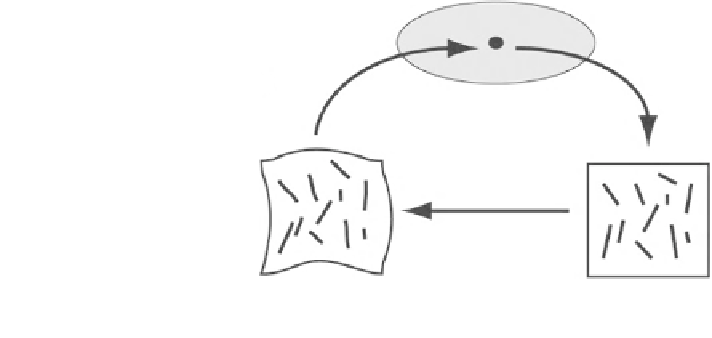Biomedical Engineering Reference
In-Depth Information
Fig. 7 FE
2
homogenization
procedure. The FE
2
method
solves a nested FE problem in
which the deformation
gradient F
macro
computed at a
macroscale point is passed to
the microscale RVE. A
homogenization is performed
using the deformation
gradient coupled with
suitable boundary conditions,
and the resulting stress tensor
(r
macro
) and elasticity tensor
C
macro
are passed back to the
macroscale. Figure adapted
from [
128
]
Macroscale
σ
macro
F
macro
C
macro
Micro Problem
Homogenization
RVE
(Fig.
7
). Thus, the constitutive model is itself an FE problem. This framework
provides a generalized strategy for performing a nonlinear homogenization on an
arbitrarily defined RVE. The primary downside to this methodology is the sub-
stantial increase in computational demand. However, increased computing power
coupled with parallelization methods will make future FE
2
considerably faster
[
169
].
A fundamental assumption for the aforementioned homogenization approaches
is that the RVE is infinitesimally small in comparison to the macroscale. Under
this assumption, a homogenous deformation is described via the deformation
gradient (Eq.
2
). Since the deformation gradient is computed by taking a first order
derivative, continuum based homogenization methods are referred to as 1st order
methods. Some homogenization problems, however, feature RVEs that are not
infinitesimally small in comparison to the macroscale. In these cases, micro-
structural size effects must be taken into account [
39
,
129
]. This is particularly
relevant in the study of damage initiation, as size effects play a critical role in this
field [
122
,
225
]. The most generalized approach to accounting for these size effects
is to utilize 2nd order FE
2
strategies. In these methods, a microscale RVE problem
is still used. However, the homogenization utilizes a quadratic version of the
deformation map. In this method a Taylor series expansion is used to express the
infinitesimal material line element dx as:
þ
X
0
;
dx
¼
F
dX
þ
1
2
dX
3
G
dX
ð
12
Þ
where the 3rd-order tensor
3
G
¼r
F is used. This method explicitly accounts for
the length scale through the size of the RVE, and thus allows for computational
homogenization of materials for which the assumptions of the 1st order method are
not appropriate. Second order methods are particularly attractive for biological
materials, as physical scales are often not separated sufficiently in size. As an
example,
the
microstructures
in
ligament
and
tendon
have
similar
physical
dimensions
to
the
macroscale.
Fascicles,
for
instance,
have
a
diameter
of

Search WWH ::

Custom Search